Acornsoft was the software arm of Acorn Computers, and a major publisher of software for the BBC Micro and Acorn Electron. As well as games, it also produced a large number of educational titles, extra computer languages and business and utility packages – these included word processor VIEW and the spreadsheet ViewSheet supplied on ROM and cartridge for the BBC Micro/Acorn Electron and included as standard in the BBC Master and Acorn Business Computer.
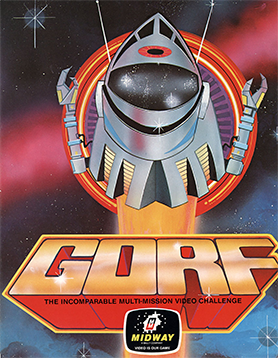
Gorf is an arcade video game released in 1981 by Midway Manufacturing, whose name was advertised as an acronym for "Galactic Orbiting Robot Force". It is a fixed shooter with five distinct levels, the first of which is based on Space Invaders and another on Galaxian. The game makes heavy use of synthesized speech for the Gorfian robot which taunts the player, powered by the Votrax speech chip. Gorf allows the player to buy two additional lives per quarter before starting the game, for a maximum of seven lives.
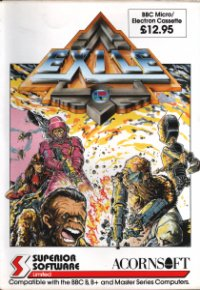
Exile is a single-player action-adventure video game originally published for the BBC Micro and Acorn Electron in 1988 by Superior Software and later ported to the Commodore 64, Amiga, CD32 and Atari ST, all published by Audiogenic. The game was designed and programmed by Peter Irvin and Jeremy Smith. It is often cited as one of the earliest examples of a Metroidvania game and featured "realistic gravity, inertia and object mass years before players understood the concept of a physics engine... an astounding level of AI, stealth-based gameplay, a logical ecosystem governing the world's creatures and a teleportation mechanic that feels startlingly like a predecessor to Portal".
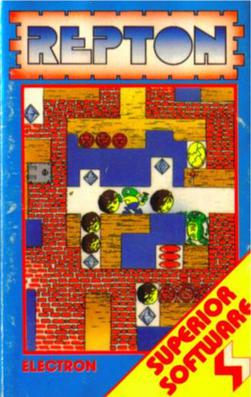
Repton is a video game originally developed by 16-year-old Briton Tim Tyler for the BBC Micro and Acorn Electron and released by Superior Software in 1985. The game spawned a series of follow up games which were released throughout the 1980s. The series sold around 125,000 copies between 1985 and 1990 with Repton 2 selling 35,000 itself. The games have since been remade for several modern systems, including iRepton for the iPhone / iPod Touch in 2010, and Android Repton 1, Android Repton 2 and Android Repton 3 from 2016 to 2018.

Chuckie Egg is a platform game released by A&F Software in 1983 initially for the ZX Spectrum, BBC Micro, and Dragon 32/64. It was ported to the Commodore 64, Acorn Electron, MSX, Tatung Einstein, Amstrad CPC, and Atari 8-bit computers. It was later updated for the Amiga, Atari ST, and IBM PC compatibles.
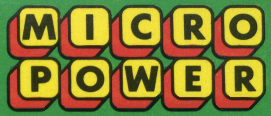
Micro Power was a British company established in the early 1980s by former accountant Bob Simpson. The company was best known as a video game publisher, originally under the name Program Power. It also sold many types of computer hardware and software through its Leeds 'showroom' or via mail order.
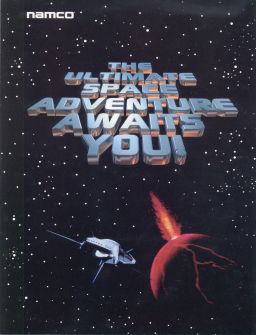
Galaxian3: Project Dragoon is a 3D rail shooter video game developed and published by Namco. It was originally a theme park attraction designed for the International Garden and Greenery Exposition in Japan, and was later released as an arcade game in 1992. The game involves players controlling a starship named the Dragoon in its mission to destroy Cannon Seed, a superweapon set to destroy what is left of the human race.
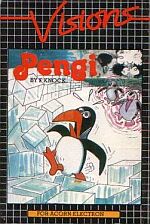
Pengi is a game for the Acorn Electron and BBC Micro, released by Visions Software in 1984. It is a direct clone of the 1982 Sega arcade game Pengo, even down to calling the enemies "snow bees," as in the original.
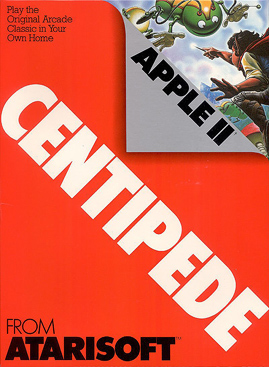
Atarisoft was a brand name used by Atari, Inc. in 1983 and 1984 to publish video games for non-Atari home computers and consoles. Each platform had a specific color for its game packages: video games sold for the Commodore 64 were in green boxes, games for the TI-99/4A in yellow, the IBM PC in blue, and so on.

Cybertron Mission is a multidirectional shooter released by Micro Power in 1983 for the BBC Micro and Acorn Electron and ported to the Commodore 64 in the same year. The game is heavily influenced by the 1982 Atari 8-bit game Shamus, which was itself inspired by the 1980 arcade video game Berzerk.
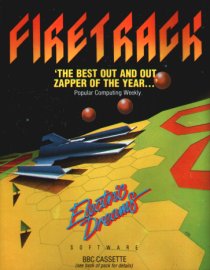
Firetrack is a vertically-scrolling shooter programmed by Nick Pelling and released for the BBC Micro and Commodore 64 platforms in 1987 by Electric Dreams Software. It was also ported to the Acorn Electron by Superior Software in 1989 as part of the Play It Again Sam 7 compilation. It resembles the 1984 arcade game Star Force in style and gameplay. The game was technically advanced and very well received by critics.

Snapper is a clone of the Namco arcade game Pac-Man programmed by Jonathan Griffiths for the BBC Micro and released as one of the launch titles for Acornsoft in 1982. It was also one of Acornsoft's launch titles for the Acorn Electron in 1983.

Stryker's Run is a video game designed by Chris Roberts and Philip Meller for the BBC Micro and BBC Master which was published by Superior Software in 1986. It was also later converted to the Acorn Electron. It is a 2D side-scrolling action game. It was well received, particularly for its graphics.
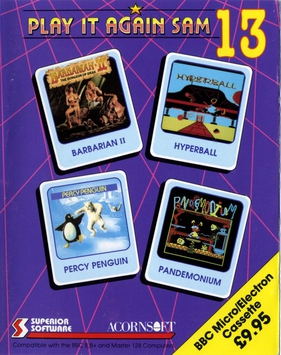
Hyperball is a clone of the 1986 arcade game Arkanoid created for the Acorn Electron and BBC Micro. It was released as part of the compilation Play It Again Sam 13 in 1990.

Moon Cresta is a fixed shooter video game released by Nichibutsu for arcades in 1980. In North America, it was licensed to Sega/Gremlin and Centuri, the latter releasing it in arcades as Eagle. Incentive Software published ports of Moon Cresta for the Amstrad CPC, Commodore 64, Dragon 32 and ZX Spectrum home computers. In 2022, the original arcade version will be included as part of the Sega Astro City Mini V, a vertically-oriented variant of the Sega Astro City mini console.
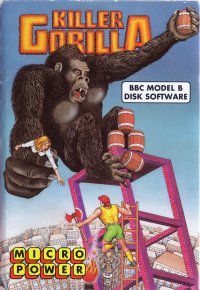
Killer Gorilla is a Donkey Kong clone written by Adrian Stephens and published by Micro Power for the BBC Micro in 1983. It was ported to the Acorn Electron and Amstrad CPC computers in 1984.

Check Man is an arcade video game released by Zilec-Zenitone in 1982. While being a fast-paced action game, there are puzzle elements to the gameplay. The game uses the Namco Galaxian arcade board. It was one of the first British video games to be successful in overseas markets, particularly Japan.

Frenzy is an 8-bit computer game published in the UK by Micro Power in 1984. It is a version of the arcade game Qix. The game was released for the Acorn Electron and BBC Micro in 1984 and for the Commodore 64 in 1985.
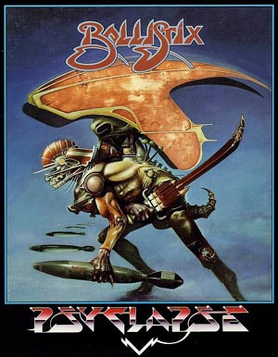
Ballistix is a video game created by Martin Edmondson for the Amiga and Atari ST and published by Psyclapse in 1989. It was also converted to a number of other home computers in the same year and the PC Engine/TurboGrafx-16 console in 1991. It is a fictional futuristic sport involving directing a puck to a goal by shooting small balls at it.
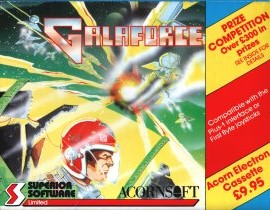
Galaforce is a fixed shooter video game for the BBC Micro and Acorn Electron, written by Kevin Edwards and published by Superior Software in 1986. It spawned a sequel, Galaforce 2 (1988), and later, Galaforce Worlds (2003).




















